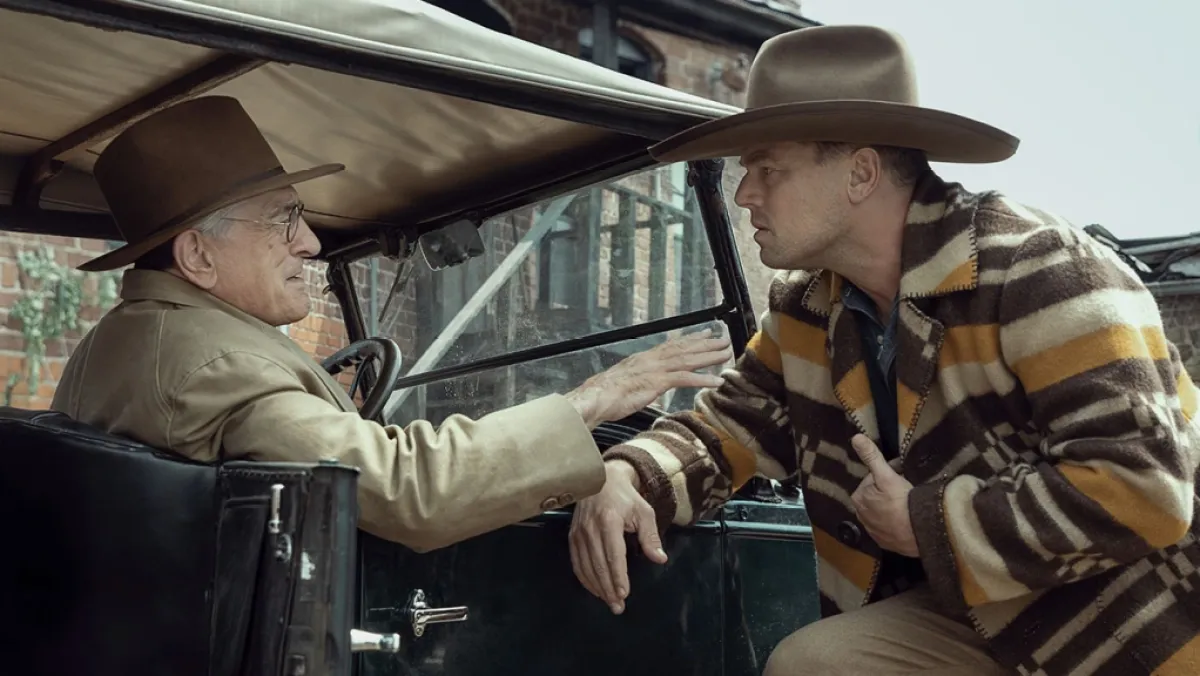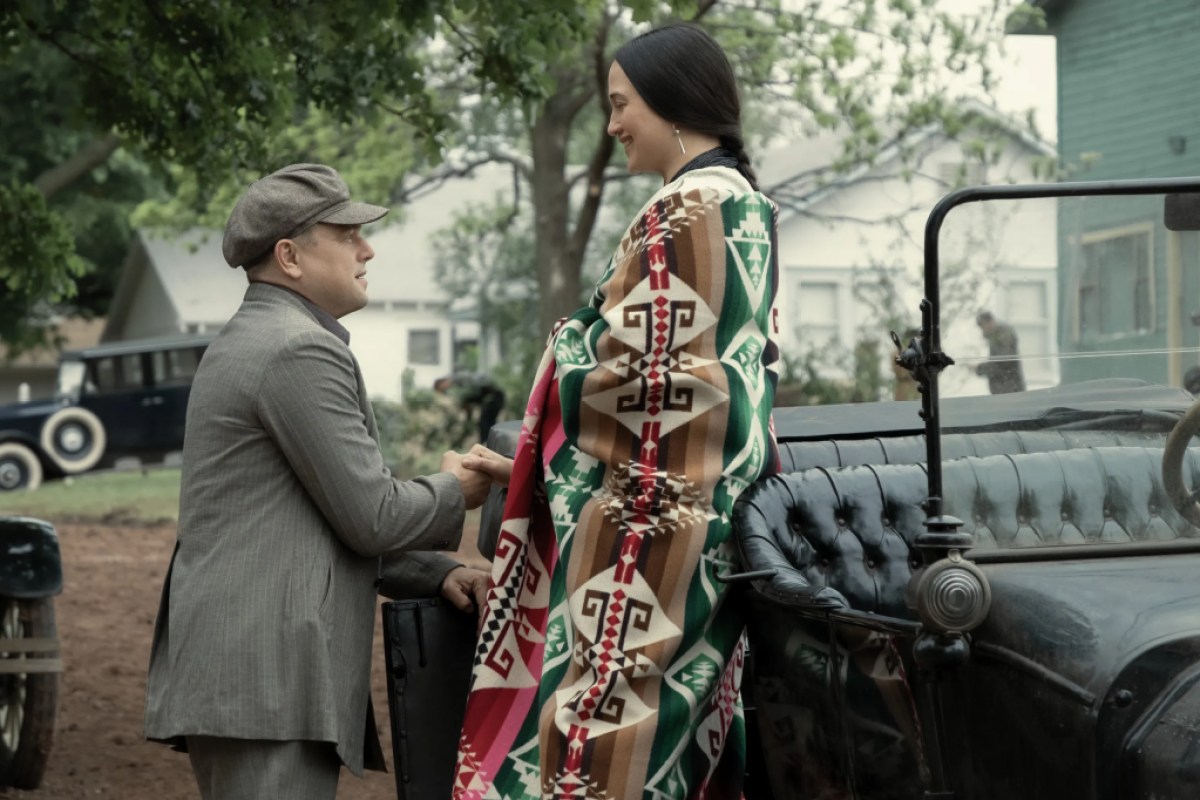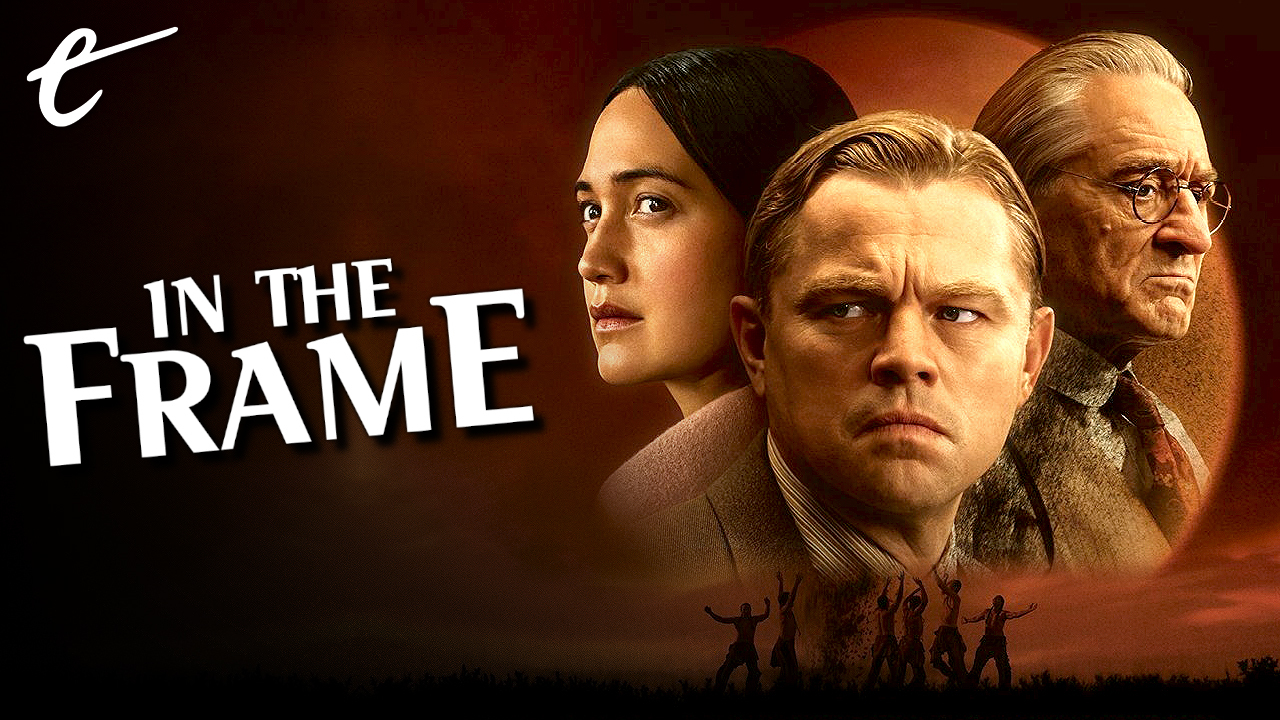Warning: The following article about Killers of the Flower Moon confronting where masculinity meets white supremacy contains spoilers.
Killers of the Flower Moon is an epic from a defining American filmmaker. It is a western and a crime story, a romance and a tragedy. It is the history the United States played out in miniature, against the backdrop of a series of murders of wealthy indigenous people in Osage County. As one expects from director Martin Scorsese, it is a story of the intertwined forces of masculinity and capitalism. However, it’s also a study of those intersected with white supremacy.
Scorsese’s movies are preoccupied with the idea of masculinity. It simmers through virtually his entire filmography, but is most pronounced in movies like Mean Streets, Taxi Driver, Raging Bull, Goodfellas, The Departed, and The Wolf of Wall Street. He is also fascinated with the way that American culture is shaped by capitalism, but not just in his gangster films like Goodfellas and Casino, but also in movies like The Color of Money, The Aviator, and The Wolf of Wall Street.
However, race has always been something of a blind spot for Scorsese, as noted by critics like Ashley Clark. While Scorsese’s movies tend to focus on outsiders to a particular subculture, like the Irish Henry Hill (Ray Liotta) in Goodfellas or Frank Sheehan (Robert De Niro) in The Irishman or the Jewish Sammy “Ace” Rothstein (De Niro) in Casino, his movies haven’t always had a broad perspective that includes cultures outside traditionally “white” America.
Related: Martin Scorsese’s Killers of the Flower Moon Trailer Asks If You Can Find the Wolves

Of course, it is easy to overstate this. Race ends up being a major part of the climax of Gangs of New York, with draft riots sweeping through the city. Scorsese also directed Kundun, about the life and times of the Dalai Lama. Scorsese has also used his platform to champion minority filmmakers telling stories from their own perspectives. He famously established The Film Foundation, which supports initiatives like The World Cinema Project and The African Film Heritage Project.
Indeed, it’s a valid question to ask whether it is Scorsese’s place to tell stories about these other communities. They have their own voices and their own filmmakers after all, even if Scorsese occupies a rarified place in the popular consciousness. Still, there is something to be said for white filmmakers engaging with the question and the legacy of racism in America’s history. Certainly, the Osage people have embraced and encouraged Scorsese, nicknaming him “Uncle Marty.”
Scorsese has made western-adjacent projects before. To varying degrees, The Age of Innocence, Casino, and Gangs of New York all trade in the tropes and conventions of the western, particularly the arrival of western settlers on the continent and the desire to build a new world. However, Killers of the Flower Moon marks the first time that Scorsese has engaged with the experience of the indigenous population and the violence inflicted by the settlers — America’s other original sin.
Like The Irishman, Killers of the Flower Moon plays as a belated companion piece to Scorsese’s Goodfellas. Certainly, Scorsese uses regular collaborator Robert De Niro in a very similar way. Quiet, beady-eyed and scheming, De Niro’s William King Hale feels like a spiritual ancestor of his Jimmy Conway, particularly when it comes to ruthlessly dispatching potential loose ends. The film also borrows a lot of the montage rhythm that has informed Scorsese’s work since Goodfellas.
This creates a thematic bridge. Goodfellas is a crime film. Jimmy Conway’s planning and execution of the infamous real-life Lufthansa heist is a pivot on which Goodfellas spins. It is, according to Henry, “the biggest heist in American history.” Killers of the Flower Moon suggests that King Hale masterminded an even bigger heist, displacing the indigenous settlers of Osage County and systematically robbing them of their claims to the region’s oil wells.
Of course, Killers of the Flower Moon exists in conversation with another class of film, one outside Scorsese’s filmography. Goodfellas famously (and perhaps infamously) lost the Best Picture Oscar to Kevin Costner’s Dances With Wolves. This was a source of frustration to Scorsese, who at least expected to take home Best Director. According to his then-girlfriend Illeana Douglas, he lamented, “They put me in the front row with my mother, and then I didn’t win.”
Dances With Wolves was one of the neo-westerns that emerged during the early 1990s, including movies like Unforgiven and The Quick and the Dead. In particular, films like Dances With Wolves and Michael Mann’s The Last of the Mohicans attempted to engage with the genre’s somewhat spotty history of representation of Native Americans. However, these movies did this by centering a white perspective, focusing on white men embraced and adopted by indigenous tribes.
Killers of the Flower Moon is a movie that feels informed by those earlier attempts at revisionist westerns, which focused on white men like John J. Dunbar (Costner) or Nathaniel Poe (Daniel Day-Lewis), who integrated into these communities to the point of transcending racial boundaries. The climax of The Last of the Mohicans finds Poe arguing that he is effectively more in tune with indigenous culture than the villainous Native American Magua (Wes Studi).
These movies are clumsy and uncomfortable, and they often feel like romantic fantasies of white Americans who want to acknowledge the injustices committed against the native population while still framing white characters as the heroes of these narratives. In contrast, Killers of the Flower Moon plays with this idea, focusing on white men marrying into Osage families. However, this is not a heroic act. It is one of usurpation and displacement. It’s an act of violence and oppression.
Killers of the Flower Moon is a typical Scorsese film in many ways. It is preoccupied with masculine anxieties. Its male characters are insecure, and that insecurity tends to push them toward violence. This is a story in which the women, who come from the indigenous population, tend to hold the wealth and the political power. The white men marry them in an effort to claim some of that power for themselves. There’s a sense that this imbalance makes the men uncomfortable.
Related: Scorsese’s Killers of the Flower Moon Gets Violent in Official Trailer
King Hale’s nephew, Bryan Burkhart (Scott Shepherd), marries Anna (Cara Jade Myers). However, he bristles at her ostentatious displays of wealth and her power over him. He responds by sexually assaulting their nanny (Sarah Spurger) as a way of asserting his masculinity, and eventually conspires to murder Anna. The term “squaw man” is whispered as an insult by these husbands who depend on their wives’ wealth to live. It is implied to be a thoroughly emasculating experience for these men.
Bryan’s brother Ernest (Leonardo DiCaprio) marries Anna’s sister Mollie (Lily Gladstone). He initially has to work as her driver, and she has to buy him his Stetson cowboy hat. Ernest is initially unenthused about King Hale’s plans to murder Henry Roan (William Belleau), but seems to be convinced once he discovers that Henry was Mollie’s first husband. For his part, Henry is driven into a drunken rage by his own wife’s affair with the local butcher, Roy Bunch (Joey Oglesby).
The western is a genre firmly tied to ideas of white male masculinity, which makes interrogations of the concept in projects like The Power of the Dog so compelling and subversive. King Hale owns a cattle ranch, one of the most potent images of the Wild West. Ernest names his son “Cowboy” (River Rhoades), a direct invocation of that rugged stereotypical masculinity, and one very much at odds with how the men in The Killers of the Flower Moon behave.
Of course, the western is also a genre about the march of capitalism. Money is power. As Killers of the Flower Moon explains, Osage County was once the most prosperous region of the country per capita. The schemes to displace the indigenous population are largely financial in nature. King Hale even takes out insurance policies on men that he murders, including Henry. “We mix these families together,” King Hale tells Ernest, “and that estate money flows the right direction, it’ll come to us.”
However, Killers of the Flower Moon distinguishes itself from Scorsese’s earlier films in how it intertwines these two recurring Scorsese fascinations with the idea of systemic racism. Killers of the Flower Moon is about an attempt to wipe out the indigenous population. Guns and murder are part of that ethnic cleansing, but so is sex. These white men try to erase the Osage through marriage and genealogy. White relatives note the skin colors of the children, pondering which can pass as white.
Killers of the Flower Moon is a true story set in the 1920s, but it resonates today. In particular, it understands that white supremacy is often rooted in an anxiety around masculinity and impotence. This is why the term “cuck” has become such a common insult among white nationalists, as it suggests the fear of racial displacement through sexual reproduction. It’s the fear that underpins conspiracy theories like “the great replacement” and informs obsessions around racial birth rates.
Killers of the Flower Moon understands this point of intersection. Despite insisting that everybody call him “King,” Hale has no male heirs. Bryan and Ernest are his nephews, not his sons. Ernest cannot even protect his own family, with his daughter Lizzie (Kinsleigh McNac) dying from illness. Hale speaks in the language of modern white supremacy, warning Ernest, “We’ve got to take back control of our home.” It feels very much informed by the chants of “you will not replace us,” tapping into the white male anxiety that their racial bloodline might not endure.
One of the great rhetorical tricks of this sort of populism is displacement and projection — to accuse one’s enemy of one’s own sins. Interestingly, Killers of the Flower Moon returns repeatedly to a familiar western trope as scalps are peeled from characters’ skulls. This was a common accusation leveled at the indigenous people to prove their “savagery,” ignoring the fact that the settlers also eagerly engaged in the practice.
Related: Martin Scorsese’s Casino is a Western and a Religious Parable

When a scalp is removed in Killers of the Flower Moon, it is of an indigenous character as a result of violence from the white community. Doctors James (Steve Witting) and David Shoun (Steve Routman) peel the skin off the top of Anna’s skull while looking for the bullet that killed her. They keep her skull as a trophy. When Ernest rushes to the site of a bomb blast on their street and tries to lift Millie’s cousin Reta (JaNae Collins) off the ground amidst the wreckage, the back of her skull peels off.
Killers of the Flower Moon understands that much of this white supremacy is rooted in masculine insecurity. The sexual language and subtext employed by white nationalists is a way of displacing and projecting these sorts of sins. King Hale plots to destroy the Native Osage population through violence, but also through sex. Hale seeks to destroy a nation and its culture by displacing its men and marrying its women. It’s a very clever and nuanced understanding of the logic that underpins such hatred.
It is a movie that places this historical crime in its proper context, and which weaves together several of Scorsese’s central preoccupations into a thesis statement on white supremacy. It’s a bold and daring piece of work, and it is affirmation of Scorsese as one of the defining American filmmakers.





